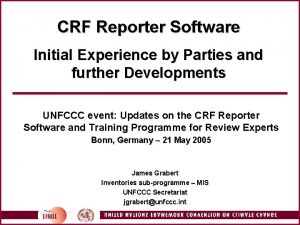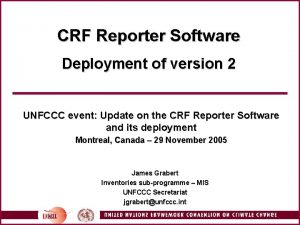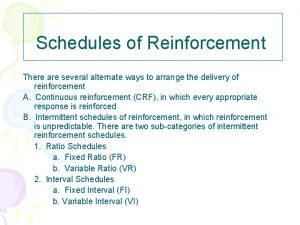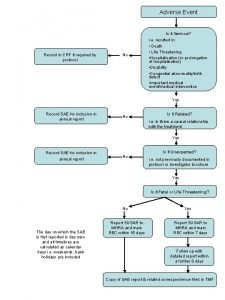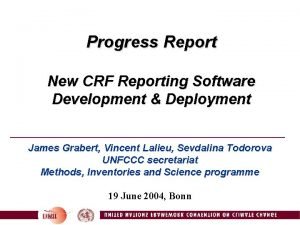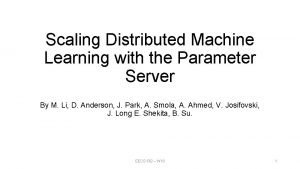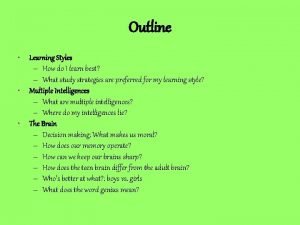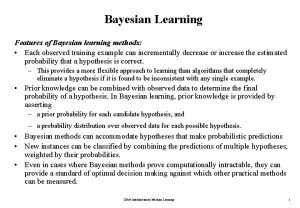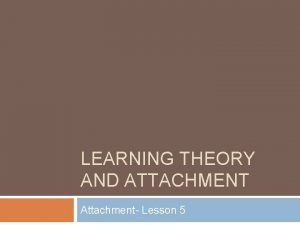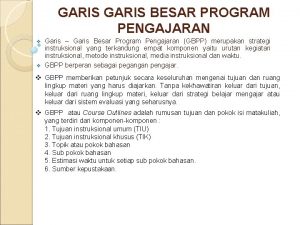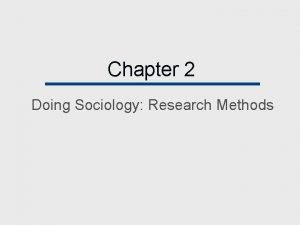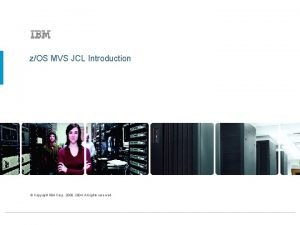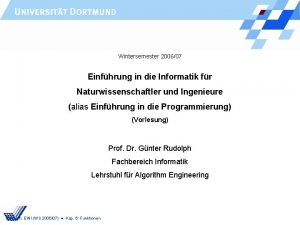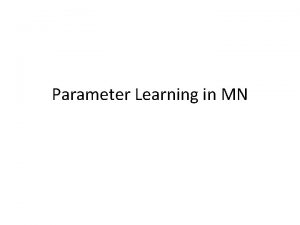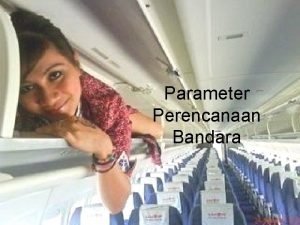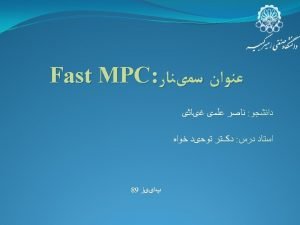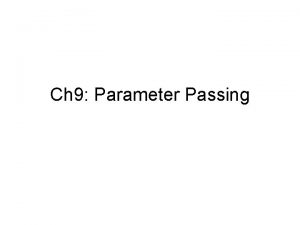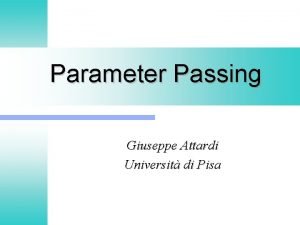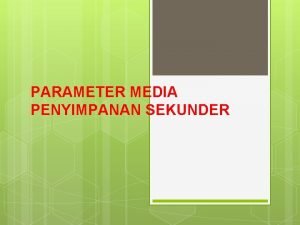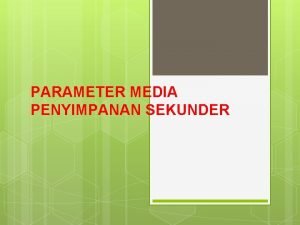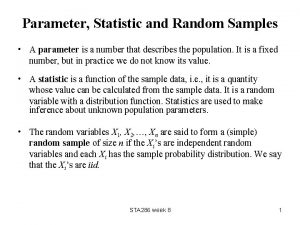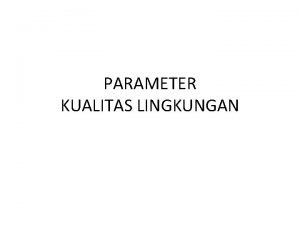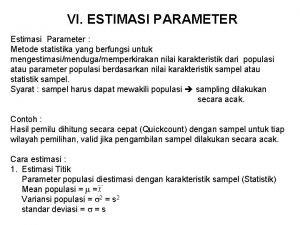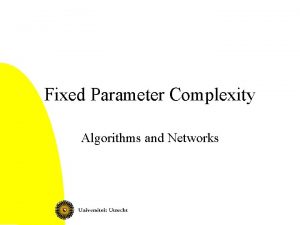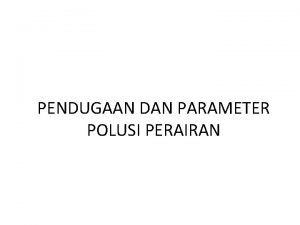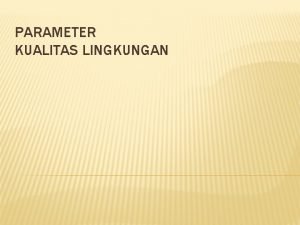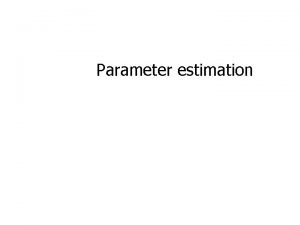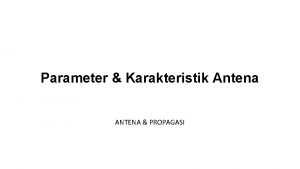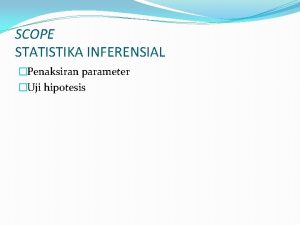Parameter Learning in MN Outline CRF Learning CRF


![Log-linear Markov network (most common representation) • Feature is some function [D] for some Log-linear Markov network (most common representation) • Feature is some function [D] for some](https://slidetodoc.com/presentation_image_h2/ff716f4c55ed115370f951ad362990d2/image-3.jpg)


![Example: Image Segmentation - A set of features 1[D 1], …, k[Dk] – each Example: Image Segmentation - A set of features 1[D 1], …, k[Dk] – each](https://slidetodoc.com/presentation_image_h2/ff716f4c55ed115370f951ad362990d2/image-6.jpg)
![Example: Image Segmentation - A set of features 1[D 1], …, k[Dk] – each Example: Image Segmentation - A set of features 1[D 1], …, k[Dk] – each](https://slidetodoc.com/presentation_image_h2/ff716f4c55ed115370f951ad362990d2/image-7.jpg)
![Example: Image Segmentation - A set of features 1[D 1], …, k[Dk] – each Example: Image Segmentation - A set of features 1[D 1], …, k[Dk] – each](https://slidetodoc.com/presentation_image_h2/ff716f4c55ed115370f951ad362990d2/image-8.jpg)

![Example: Inference for Learning How to compute E[Cfb|X[n]] y 1 y 2 y 3 Example: Inference for Learning How to compute E[Cfb|X[n]] y 1 y 2 y 3](https://slidetodoc.com/presentation_image_h2/ff716f4c55ed115370f951ad362990d2/image-10.jpg)
![Example: Inference for Learning How to compute E[Cfb|X[n]] y 1 y 2 y 3 Example: Inference for Learning How to compute E[Cfb|X[n]] y 1 y 2 y 3](https://slidetodoc.com/presentation_image_h2/ff716f4c55ed115370f951ad362990d2/image-11.jpg)









- Slides: 20

Parameter Learning in MN

Outline • CRF • Learning CRF for 2 -d image segmentation • IPF parameter sharing revisited
![Loglinear Markov network most common representation Feature is some function D for some Log-linear Markov network (most common representation) • Feature is some function [D] for some](https://slidetodoc.com/presentation_image_h2/ff716f4c55ed115370f951ad362990d2/image-3.jpg)
Log-linear Markov network (most common representation) • Feature is some function [D] for some subset of variables D – e. g. , indicator function • Log-linear model over a Markov network H: – a set of features 1[D 1], …, k[Dk] • each Di is a subset of a clique in H • two ’s can be over the same variables – a set of weights w 1, …, wk • usually learned from data – 10 -708 – �Carlos Guestrin 2006 -2008 3

Generative v. Discriminative classifiers – A review • Want to Learn: h: X �Y – X – features – Y – target classes • • Bayes optimal classifier – P(Y|X) Generative classifier, e. g. , Naïve Bayes: – – • Assume some functional form for P(X|Y), P(Y) Estimate parameters of P(X|Y), P(Y) directly from training data Use Bayes rule to calculate P(Y|X= x) This is a ‘generative’ model • Indirect computation of P(Y|X) through Bayes rule • But, can generate a sample of the data, P(X) = y P(y) P(X|y) Discriminative classifiers, e. g. , Logistic Regression: – Assume some functional form for P(Y|X) – Estimate parameters of P(Y|X) directly from training data – This is the ‘discriminative’ model • Directly learn P(Y|X) • But cannot obtain a sample of the data, because P(X) is not available 10 -708 – �Carlos Guestrin 2006 -2008 4

Log-linear CRFs (most common representation) • Graph H: only over hidden vars Y 1, . . , YP – No assumptions about dependency on observed vars X – You must always observe all of X • Feature is some function [D] for some subset of variables D – e. g. , indicator function, • Log-linear model over a CRF H: – a set of features 1[D 1], …, k[Dk] • each Di is a subset of a clique in H • two ’s can be over the same variables – a set of weights w 1, …, wk • usually learned from data – 10 -708 – �Carlos Guestrin 2006 -2008 5
![Example Image Segmentation A set of features 1D 1 kDk each Example: Image Segmentation - A set of features 1[D 1], …, k[Dk] – each](https://slidetodoc.com/presentation_image_h2/ff716f4c55ed115370f951ad362990d2/image-6.jpg)
Example: Image Segmentation - A set of features 1[D 1], …, k[Dk] – each Di is a subset of a clique in H – two ’s can be over the same y 1 y 2 y 3 y 4 y 5 y 6 y 7 y 8 y 9 variables We will define features as follows: : measures compatibility of node color and its segmentation - A set of indicator features triggered for each edge labeling pair {ff, bb, fb, bf} - This is a allowed since we can define many features overr the same subset of variables
![Example Image Segmentation A set of features 1D 1 kDk each Example: Image Segmentation - A set of features 1[D 1], …, k[Dk] – each](https://slidetodoc.com/presentation_image_h2/ff716f4c55ed115370f951ad362990d2/image-7.jpg)
Example: Image Segmentation - A set of features 1[D 1], …, k[Dk] – each Di is a subset of a clique in H – two ’s can be over the same y 1 y 2 y 3 y 4 y 5 y 6 y 7 y 8 y 9 variables
![Example Image Segmentation A set of features 1D 1 kDk each Example: Image Segmentation - A set of features 1[D 1], …, k[Dk] – each](https://slidetodoc.com/presentation_image_h2/ff716f4c55ed115370f951ad362990d2/image-8.jpg)
Example: Image Segmentation - A set of features 1[D 1], …, k[Dk] – each Di is a subset of a clique in H – two ’s can be over the same variables -Now we just need to sum these features We need to learn parameters wm y 1 y 2 y 3 y 4 y 5 y 6 y 7 y 8 y 9

Example: Image Segmentation y 1 y 2 y 3 y 4 y 5 y 6 y 7 y 8 y 9 Given N data points (images and their segmentations) Count for features m in data n Requires inference using the current parameter estimates
![Example Inference for Learning How to compute ECfbXn y 1 y 2 y 3 Example: Inference for Learning How to compute E[Cfb|X[n]] y 1 y 2 y 3](https://slidetodoc.com/presentation_image_h2/ff716f4c55ed115370f951ad362990d2/image-10.jpg)
Example: Inference for Learning How to compute E[Cfb|X[n]] y 1 y 2 y 3 y 4 y 5 y 6 y 7 y 8 y 9
![Example Inference for Learning How to compute ECfbXn y 1 y 2 y 3 Example: Inference for Learning How to compute E[Cfb|X[n]] y 1 y 2 y 3](https://slidetodoc.com/presentation_image_h2/ff716f4c55ed115370f951ad362990d2/image-11.jpg)
Example: Inference for Learning How to compute E[Cfb|X[n]] y 1 y 2 y 3 y 4 y 5 y 6 y 7 y 8 y 9

Representation Equivalence Log linear representation Tabular MN representation from HW 4 y 1 y 2 y 3 y 4 y 5 y 6 y 7 y 8 y 9

Representation Equivalence Log linear representation Tabular MN representation from HW 4 y 1 y 2 y 3 y 4 y 5 y 6 y 7 y 8 y 9 Now do it over the edge potential This is correct as for every assignment to yiyj we select one value from the table

Tabular MN representation from HW 4 Now do it over the edge potential This is correct as for every assignment to yiyj we select one value from the table The cheap exp(log. . ) trick Just algebra Now lets combine it over all edge assuming parameter sharing Now use the same Cm trick

Representation Equivalence Log linear representation Tabular MN representation from HW 4 y 1 y 2 y 3 y 4 y 5 y 6 y 7 y 8 y 9 Now substitute Equivalent, with wm = log qm Where q is the value in the tabular

Outline • CRF • Learning CRF for 2 -d image segmentation • IPF parameter sharing revisited

Iterative Proportional Fitting (IPF) Coherence Difficulty Intelligence • Setting derivative to zero: Grade SAT Letter • Fixed point equation: Happy • Iterate and converge to optimal parameters – Each iteration, must compute: 10 -708 – �Carlos Guestrin 2006 -2008 17 Job

Parameter Sharing in your HW • Note that I am suing Y for label • All edge potentials are shared • Also we are learning a conditional model y 1 y 2 y 3 y 4 y 5 y 6 y 7 y 8 y 9

IPF parameter sharing We only have one data point (image) in this example so we dropped X[n] to only X In total we have 4 parameters as opposed to 4 parameters per edge How to calculate these quantities using parameter sharing? We cancel |E| due to division Run lbp , when converged xi Yi xj Yj

 Fully connected crf
Fully connected crf Crf reporter
Crf reporter Crf software
Crf software Reinforcement schedules
Reinforcement schedules Openclinica database
Openclinica database Adverse event crf
Adverse event crf Sap collection management
Sap collection management Crf reporter
Crf reporter Nihr brc
Nihr brc Parameter server for distributed machine learning
Parameter server for distributed machine learning Paragraph sandwich example
Paragraph sandwich example Cuadro comparativo de e-learning
Cuadro comparativo de e-learning Labeling theory
Labeling theory Learning styles outline
Learning styles outline Outline brute force map learning algorithm
Outline brute force map learning algorithm Outline and evaluate the learning theory of attachment
Outline and evaluate the learning theory of attachment Tujuan garis besar adalah
Tujuan garis besar adalah Advantages and disadvantages of observation method
Advantages and disadvantages of observation method Time parameter in jcl
Time parameter in jcl Parameter (informatik)
Parameter (informatik) Vitala parametrar värden
Vitala parametrar värden

